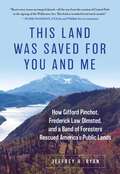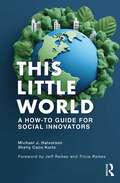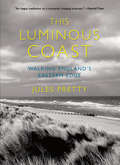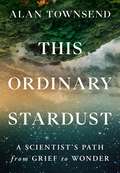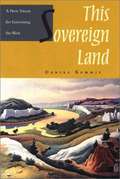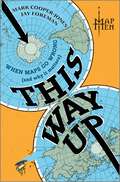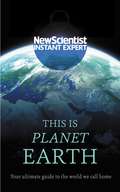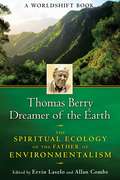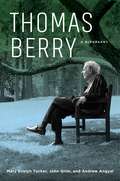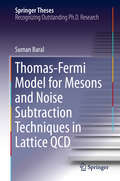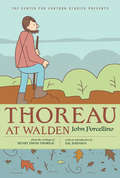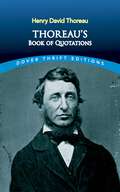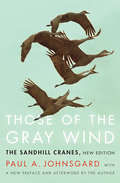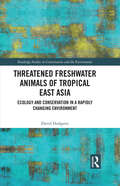- Table View
- List View
This Is Our Earth
by Laura Lee Benson John CarrozzaAn inspirational and enlightening look at our earth! Laura Lee Benson's lilting verse carries us over panoramic landscapes as we visit the many creatures and natural wonders of the earth. The subtext introduces basic facts about our diverse environment and encourages global awareness and conservation. John Carrozza's spectacular watercolor illustrations play harmoniously with the spirit of the text. At the end, the verse is set to music so all can sing along!
This Is Our Earth
by Laura Lee BensonThis is our Earth to cherish and love, To clean and protect, to take care of, From the mountains so high with their rugged terrain, To the valleys below and the green grassy plain, This is our Earth.
This Is Our Land
by Cody FergusonIn the last three decades of the twentieth century, the environmental movement experienced a quiet revolution. In This is Our Land, Cody Ferguson documents this little-noted change as he describes the efforts of three representative grassroots groups--in Montana, Arizona, and Tennessee--revealing how quite ordinary citizens fought to solve environmental problems. Here are stories of common people who, confronting environmental threats to the health and safety of their families and communities, bonded together to protect their interests. These stories include successes and failures as citizens learned how to participate in their democracy and redefined what participation meant. Equally important, Ferguson describes how several laws passed in the seventies--such as the National Environmental Policy Act--gave citizens the opportunity and the tools to fight for the environment. These laws gave people a say in the decisions that affected the world around them, including the air they breathed, the water they drank, the land on which they made their living, and the communities they called home. Moreover, Ferguson shows that through their experiences over the course of the 1970s, '80s, and '90s, these citizen activists broadened their understanding of "this is our land" to mean "this is our community, this is our country, this is our democracy, and this is our planet." As they did, they redefined political participation and expanded the ability of citizens to shape their world. Challenging us to see activism in a new way, This is Our Land recovers the stories of often-unseen citizens who have been vitally important to the environmental movement. It will inspire readers to confront environmental threats and make our world a safer, more just, and more sustainable place to live.
This Is the Way the World Ends: How Droughts and Die-Offs, Heat Waves and Hurricanes Are Converging on America
by Jeff NesbitBustle's "17 Best Nonfiction Books Coming Out In September 2018""With This is the Way the World Ends Jeff Nesbit has delivered an enlightening - and alarming - explanation of the climate challenge as it exists today. Climate change is no far-off threat. It's impacting communities all over the world at this very moment, and we ignore the scientific reality at our own peril. The good news? As Nesbit underscores, disaster is not preordained. The global community can meet this moment — and we must." —Senator John KerryA unique view of climate change glimpsed through the world's resources that are disappearing.The world itself won’t end, of course. Only ours will: our livelihoods, our homes, our cultures. And we’re squarely at the tipping point.Longer droughts in the Middle East. Growing desertification in China and Africa. The monsoon season shrinking in India. Amped-up heat waves in Australia. More intense hurricanes reaching America. Water wars in the Horn of Africa. Rebellions, refugees and starving children across the globe. These are not disconnected events. These are the pieces of a larger puzzle that environmental expert Jeff Nesbit puts together Unless we start addressing the causes of climate change and stop simply navigating its effects, we will be facing a series of unstoppable catastrophes by the time our preschoolers graduate from college. Our world is in trouble – right now. This Is the Way the World Ends tells the real stories of the substantial impacts to Earth’s systems unfolding across each continent. The bad news? Within two decades or so, our carbon budget will reach a point of no return. But there’s good news. Like every significant challenge we’ve faced—from creating civilization in the shadow of the last ice age to the Industrial Revolution—we can get out of this box canyon by understanding the realities and changing the worn-out climate conversation to one that’s relevant to every person. Nesbit provides a clear blueprint for real-time, workable solutions we can tackle together.
This Land Is Our Land: How We Lost the Right to Roam and How to Take It Back
by Ken IlgunasPrivate property is everywhere. Almost anywhere you walk in the United States, you will spot “No Trespassing” and “Private Property” signs on trees and fence posts. In America, there are more than a billion acres of grassland pasture, cropland, and forest, and miles and miles of coastlines that are mostly closed off to the public. Meanwhile, America’s public lands are threatened by extremist groups and right-wing think tanks who call for our public lands to be sold to the highest bidder and closed off to everyone else. If these groups get their way, public property may become private, precious green spaces may be developed, and the common good may be sacrificed for the benefit of the wealthy few.Ken Ilgunas, lifelong traveler, hitchhiker, and roamer, takes readers back to the nineteenth century, when Americans were allowed to journey undisturbed across the country. Today, though, America finds itself as an outlier in the Western world as a number of European countries have created sophisticated legal systems that protect landowners and give citizens generous roaming rights to their countries' green spaces. Inspired by the United States' history of roaming, and taking guidance from present-day Europe, Ilgunas calls into question our entrenched understanding of private property and provocatively proposes something unheard of: opening up American private property for public recreation. He imagines a future in which folks everywhere will have the right to walk safely, explore freely, and roam boldly—from California to the New York island, from the Redwood Forest to the Gulf Stream waters.
This Land Was Saved for You and Me: How Gifford Pinchot, Frederick Law Olmsted, and a Band of Foresters Rescued America's Public Lands
by Jeffrey H. RyanThe story of how America&’s public lands—our city parks, national forests, and wilderness areas—came into being can be traced to a few conservation pioneers and proteges who shaped policy and advocated for open spaces. Some, like Frederick Law Olmsted and Gifford Pinchot, are well known, while others have never been given their due. Jeffrey Ryan covers the nearly century-long period between 1865 (when Olmsted contributed to the creation of Yosemite as a park and created its management plan) to the signing of the Wilderness Act of 1964. Olmsted influenced Pinchot, who became the first head of the National Forest Service, and in turn, Pinchot hired the foresters who became the founders of The Wilderness Society and creators of the Wilderness Act itself. This history emphasizes the cast of characters—among them Theodore Roosevelt, Bob Marshall, Benton MacKaye, Aldo Leopold, and Howard Zahniser—and provides context for their decisions and the political and economic factors that contributed to the triumphs and pitfalls in the quest to protect public lands. In researching the book, Ryan traveled to the places where these crusaders lived, worked, and were inspired to take up the cause to make public lands accessible to all.
This Land: How Cowboys, Capitalism, and Corruption are Ruining the American West
by Christopher KetchamA hard-hitting look at the battle now raging over the fate of the public lands in the American West--and a plea for the protection of these last wild placesThe public lands of the western United States comprise some 450 million acres of grassland, steppe land, canyons, forests, and mountains. It's an American commons, and it is under assault as never before.Journalist Christopher Ketcham has been documenting the confluence of commercial exploitation and governmental misconduct in this region for over a decade. His revelatory book takes the reader on a journey across these last wild places, to see how capitalism is killing our great commons. Ketcham begins in Utah, revealing the environmental destruction caused by unregulated public lands livestock grazing, and exposing rampant malfeasance in the federal land management agencies, who have been compromised by the profit-driven livestock and energy interests they are supposed to regulate. He then turns to the broad effects of those corrupt politics on wildlife. He tracks the Department of Interior's failure to implement and enforce the Endangered Species Act--including its stark betrayal of protections for the grizzly bear and the sage grouse--and investigates the destructive behavior of U.S. Wildlife Services in their shocking mass slaughter of animals that threaten the livestock industry. Along the way, Ketcham talks with ecologists, biologists, botanists, former government employees, whistleblowers, grassroots environmentalists and other citizens who are fighting to protect the public domain for future generations. This Land is a colorful muckraking journey--part Edward Abbey, part Upton Sinclair--exposing the rot in American politics that is rapidly leading to the sell-out of our national heritage. The book ends with Ketcham's vision of ecological restoration for the American West: freeing the trampled, denuded ecosystems from the effects of grazing, enforcing the laws already in place to defend biodiversity, allowing the native species of the West to recover under a fully implemented Endangered Species Act, and establishing vast stretches of public land where there will be no development at all, not even for recreation.
This Land: The Battle over Sprawl and the Future of America
by Anthony FlintDespite a modest revival in city living, Americans are spreading out more than ever—into "exurbs" and "boomburbs" miles from anywhere, in big houses in big subdivisions. We cling to the notion of safer neighborhoods and better schools, but what we get, argues Anthony Flint, is long commutes, crushing gas prices and higher taxes—and a landscape of strip malls and office parks badly in need of a makeover.This Land tells the untold story of development in America—how the landscape is shaped by a furious clash of political, economic and cultural forces. It is the story of burgeoning anti-sprawl movement, a 1960s-style revolution of New Urbanism, smart growth, and green building. And it is the story of landowners fighting back on the basis of property rights, with free-market libertarians, homebuilders, road pavers, financial institutions, and even the lawn-care industry right alongside them.The subdivisions and extra-wide roadways are encroaching into the wetlands of Florida, ranchlands in Texas, and the desert outside Phoenix and Las Vegas. But with up to 120 million more people in the country by 2050, will the spread-out pattern cave in on itself? Could Americans embrace a new approach to development if it made sense for them?A veteran journalist who covered planning, development, and housing for the Boston Globe for sixteen years and a visiting scholar in 2005 at the Harvard Design School, Flint reveals some surprising truths about the future and how we live in This Land.
This Land: The Battle over Sprawl and the Future of America
by Anthony FlintAn expert in American housing examines the rise of sprawling subdivisions, their effect on the environment, and sustainable development strategies.Americans are spreading out more than ever—into “exurbs” and “boomburbs” miles from anywhere, where big subdivisions offer big houses. We cling to the notion of safer neighborhoods and better schools, but what we get are longer commutes, higher taxes, and a landscape of strip malls and office parks.The subdivisions and extra-wide roadways are encroaching into the wetlands of Florida, ranchlands in Texas, and the desert outside Phoenix and Las Vegas. But with up to 120 million more people in the country by 2050, will the spread-out pattern cave in on itself? Could Americans embrace a new approach to development?In This Land, veteran journalist and Harvard scholar Anthony Flint tells the untold story of development in America. It is the story of a burgeoning anti-sprawl movement, a 1960s-style revolution of New Urbanism, smart growth, and green building. And it is the story of landowners fighting back on the basis of property rights, with free-market libertarians, homebuilders, road pavers, financial institutions, and even the lawn-care industry right alongside them.
This Little World: A How-To Guide for Social Innovators
by Michael J. Halvorson Shelly Cano KurtzOur planet has never been smaller. Technological advancements have compressed time and space, making the world more immediate and interconnected. This Little World clearly sets out how social innovation practices can enable organizations and communities to create a more sustainable, just, and equitable future for our shared lives on Earth.Today, cloud‑based communication systems span the globe, connecting people and markets in the blink of an eye. Remote workers interact daily on high‑impact, virtual teams. Telehealth professionals provide medical care to the residents of secluded mountain villages. But a shrinking planet is not without its challenges: climate change, food shortages, pollution, and war are persistent headwinds. We need strategies and tools that promote stability and growth, and we need technology that is more inclusive, trusted, and focused on community goals. This Little World seeks to inspire those who aim to explore the rich and rewarding world of social innovation. It is a practical guide to innovation opportunities that will enrich an organization’s capacity for transformation and impact. The book explores how social impact employees can create projects that are purpose‑driven, scalable, and successful. With insights from leading social innovators, the book demonstrates how "tech for good" organizations are using social innovation strategies, emerging tools, and sustainable practices to support environmental causes, humanitarian initiatives, accessibility, healthcare, cultural heritage, and more.This Little World: A How‑To Guide for Social Innovators is for technologists, business leaders, managers, and employees in the social impact sector, as well as anyone with aspirations for purpose‑driven outcomes in their work. Corporate executives, entrepreneurs, and students alike can learn from this new model of innovation, where it is possible to do good and do well. For more about the This Little World project, visit www.thislittleworld.org.
This Luminous Coast: Walking England’s Eastern Edge
by Jules PrettyOver the course of a year, Jules Pretty walked along the shoreline of East Anglia in southeastern England, eventually exploring four hundred miles on foot (and another hundred miles by boat). It is a coast and a culture that is about to be lost—not yet, perhaps, but soon—to rising tides and industrial sprawl. This Luminous Coast takes the reader with him on his journey over land and water; over sea walls of dried grass, beside stretched fields of golden crops, alongside white sails gliding across the intricate lacework of invisible creeks and estuaries, under vast skies that are home to curlews and redshanks and the outpourings of skylarks. East Anglia's coastline is as much a human landscape as it is a natural one, and Pretty is equally perceptive about the region's cultural heritage and its "industrial wild": fishing villages and the modern seaside resorts, family farms and oil refineries, pleasure piers and concrete seawalls, cozy pubs and military installations. Through words and photographs, Pretty interweaves stories of the land and sea with people past and present. He is a passionate and sensitive guide to a region in transition, under stress, and perhaps even doomed, as finely attuned to its history as he is to its unique sensory world.
This Ordinary Stardust: A Scientist's Path from Grief to Wonder
by Alan Townsend"[A] remarkable account of a shifting consciousness&” - Publisher&’s Weekly, starred review &“An extraordinary, powerful book&” - David Quammen, author of The Heartbeat of the Wild and Breathless A compassionate exploration of scientific wonder that offers &“a fresh perspective on life, death, and the bittersweet consequences of impermanence,&” (Jon Krakauer) as illuminated through the tragic dual cancer diagnoses of author Dr. Alan Townsend&’s wife and daughter. A decade ago, Dr. Alan Townsend&’s family received two unthinkable, catastrophic diagnoses: his 4-year-old daughter and his brilliant scientist wife developed unrelated, life-threatening forms of brain cancer. As he witnessed his young daughter fight during the courageous final months of her mother&’s life, Townsend – a lifelong scientist – was indelibly altered. He began to see scientific inquiry as more than a source of answers to a given problem, but also as a lifeboat: a lens on the world that could help him find peace with the painful realities he could not change. Through scientific wonder, he found ways to bring meaning to his darkest period. At a time when society&’s relationship with science is increasingly polarized while threats to human life on earth continue to rise, Townsend offers a balanced, moving perspective on the common ground between science and religion through the spiritual fulfillment he found in his work. Awash in Townsend's electrifying and breathtaking prose, THIS ORDINARY STARDUST offers hope that life can carry on even in the face of near-certain annihilation.
This Sovereign Land
by Daniel KemmisThe westerner and the democrat has long been convinced, and because of this the author found himself disagreeing with his environmentalist and Democrat friends. So deep are some of these disagreements that the author has often doubted whether he was actually seeing what he thought he saw in the West. Despite these strong feelings he has tried to convey his understanding of the West, where it has been and where it is going.
This Way Up: When Maps Go Wrong (And Why It Matters)
by Map MenThe debut book from the YouTube sensation and all-round cartographical nerds, The Map Men!Hello, we&’re the Map Men and in the following pages, we&’ve selected what we believe to be some of the very best wrong maps. Some of them are decades old, some are centuries old, and some are so recent they&’re still being published today (or yesterday, if you&’re reading this tomorrow).In This Way Up, we delve into laugh-out-loud funny, hilarious geographical gaffes, including: world maps that forego entire countries colonial maps with mathematically impossible borders and made-up mountain ranges maps of US states with fake cities painfully incorrect maps on live news channels ...and more!Whether you&’re an avid map junkie or simply "map-curious," each chapter uncovers a unique tale of adventure, error and unexpected humor – as we attempt to answer the question: "What on earth happened here?"So, ditch the compass (or open settings and tap &‘disable location services&’) and set out on a journey with us, the Map Men, into a world of cartographic chaos and mappy mishaps. Because the worst maps are the best maps.
This is Planet Earth: Your ultimate guide to the world we call home (Instant Expert Ser.)
by New ScientistThe ancient Greeks called it Gaia; the Romans Terra. We know it simply as Earth, the planet we call home. And what a planet it is.Formed around 4.6 billion years ago from the debris of the big bang and long-dead stars, at first it was nothing special, but somehow it evolved to become the most amazing place in the known Universe. The only living planet we know of, it also has a very unusual moon, a remarkably dynamic surface, a complex atmosphere and a deeply mysterious interior.This is Planet Earth is dedicated to the wonders of Planet Earth. Its past is long and dramatic and its future shrouded in mystery. Yet despite centuries of research, only now are we starting to understand Earth's complexity.ABOUT THE SERIESNew Scientist Instant Expert books are definitive and accessible entry points to the most important subjects in science; subjects that challenge, attract debate, invite controversy and engage the most enquiring minds. Designed for curious readers who want to know how things work and why, the Instant Expert series explores the topics that really matter and their impact on individuals, society, and the planet, translating the scientific complexities around us into language that's open to everyone, and putting new ideas and discoveries into perspective and context.
This is Planet Earth: Your ultimate guide to the world we call home (Instant Expert)
by New ScientistThe ancient Greeks called it Gaia; the Romans Terra. We know it simply as Earth, the planet we call home. And what a planet it is.Formed around 4.6 billion years ago from the debris of the big bang and long-dead stars, at first it was nothing special, but somehow it evolved to become the most amazing place in the known Universe. The only living planet we know of, it also has a very unusual moon, a remarkably dynamic surface, a complex atmosphere and a deeply mysterious interior.This is Planet Earth is dedicated to the wonders of Planet Earth. Its past is long and dramatic and its future shrouded in mystery. Yet despite centuries of research, only now are we starting to understand Earth's complexity.
This is Planet Earth: Your ultimate guide to the world we call home (New Scientist Instant Expert)
by New ScientistThe ancient Greeks called it Gaia; the Romans Terra. We know it simply as Earth, the planet we call home. And what a planet it is.Formed around 4.6 billion years ago from the debris of the big bang and long-dead stars, at first it was nothing special, but somehow it evolved to become the most amazing place in the known Universe. The only living planet we know of, it also has a very unusual moon, a remarkably dynamic surface, a complex atmosphere and a deeply mysterious interior.This is Planet Earth is dedicated to the wonders of Planet Earth. Its past is long and dramatic and its future shrouded in mystery. Yet despite centuries of research, only now are we starting to understand Earth's complexity.ABOUT THE SERIESNew Scientist Instant Expert books are definitive and accessible entry points to the most important subjects in science; subjects that challenge, attract debate, invite controversy and engage the most enquiring minds. Designed for curious readers who want to know how things work and why, the Instant Expert series explores the topics that really matter and their impact on individuals, society, and the planet, translating the scientific complexities around us into language that's open to everyone, and putting new ideas and discoveries into perspective and context.
This is Planet Earth: Your ultimate guide to the world we call home (New Scientist Instant Expert)
by New ScientistThis Is Planet Earth is dedicated to the wonders of Planet Earth, the most amazing place in the known Universe.The ancient Greeks called it Gaia; the Romans Terra. We know it simply as Earth, the planet we call home. And what a planet it is.Formed around 4.6 billion years ago from the debris of the big bang and long-dead stars, at first it was nothing special, but somehow it evolved to become the most amazing place in the known Universe. The only living planet we know of, it also has a very unusual moon, a remarkably dynamic surface, a complex atmosphere and a deeply mysterious interior.This is Planet Earth is dedicated to the wonders of Planet Earth. Its past is long and dramatic and its future shrouded in mystery. Yet despite centuries of research, only now are we starting to understand Earth's complexity.ABOUT THE SERIESNew Scientist Instant Expert books are definitive and accessible entry points to the most important subjects in science; subjects that challenge, attract debate, invite controversy and engage the most enquiring minds. Designed for curious readers who want to know how things work and why, the Instant Expert series explores the topics that really matter and their impact on individuals, society, and the planet, translating the scientific complexities around us into language that's open to everyone, and putting new ideas and discoveries into perspective and context.(P)2018 Hodder & Stoughton Limited
Thomas Berry, Dreamer of the Earth: The Spiritual Ecology of the Father of Environmentalism
by Ervin Laszlo Allan CombsA tribute to the visionary contributions and prophetic writings of Thomas Berry, spiritual ecologist and father of environmentalism • Contains 10 essays by eminent philosophers, thinkers, and scientists in the field of ecology and sustainability, including Matthew Fox, Joanna Macy, Duane Elgin, Sean Esbjörn-Hargens, Ervin Laszlo, and Allan Combs • Calls for a transformation of consciousness to resolve today’s global ecological and human challenges • Includes a little-known but essential essay by Thomas Berry When cultural historian and spiritual ecologist Thomas Berry, described by Newsweek magazine as “the most provocative figure among the new breed of eco-theologians,” passed away in 2009 at age 94, he left behind a dream of healing the “Earth community.” In his numerous lectures, books, and essays, Berry proclaimed himself a scholar of the earth, a “geologian,” and diligently advocated for a return to Earth-based spirituality. This anthology presents 10 essays from leading philosophers, scientists, and spiritual visionaries--including Matthew Fox, Joanna Macy, Duane Elgin, Sean Esbjörn-Hargens, Ervin Laszlo, and Allan Combs--on the genius of Berry’s work and his quest to resolve our global ecological and spiritual challenges, as well as a little-known but essential essay by Berry himself. Revealing Berry’s insights as far ahead of their time, these essays reiterate the radical nature of his ideas and the urgency of his most important conclusion: that money and technology cannot solve our problems, rather, we must reestablish the indigenous connection with universal consciousness and return to our fundamental spontaneous nature--still evident in our dreams--in order to navigate our ecological challenges successfully.
Thomas Berry: A Biography (G - Reference, Information And Interdisciplinary Subjects)
by Mary Evelyn Tucker John Grim Andrew AngyalThomas Berry (1914–2009) was one of the twentieth century’s most prescient and profound thinkers. As a cultural historian, he sought a broader perspective on humanity’s relationship to the earth in order to respond to the ecological and social challenges of our times. This first biography of Berry illuminates his remarkable vision and its continuing relevance for achieving transformative social change and environmental renewal.Berry began his studies in Western history and religions and then expanded to include Asian and indigenous religions, which he taught at Fordham University, Barnard College, and Columbia University. Drawing on his explorations of history, he came to see the evolutionary process as a story that could help restore the continuity of humans with the natural world. Berry urged humans to recognize their place on a planet with complex ecosystems in a vast, evolving universe. He sought to replace the modern alienation from nature with a sense of intimacy and responsibility. Berry called for new forms of ecological education, law, and spirituality, as well as the creation of resilient agricultural systems, bioregions, and ecocities. At a time of growing environmental crisis, this biography shows the ongoing significance of Berry’s conception of human interdependence with the earth as part of the unfolding journey of the universe.
Thomas-Fermi Model for Mesons and Noise Subtraction Techniques in Lattice QCD (Springer Theses)
by Suman BaralThis thesis make significant contributions to both the numerical and analytical aspects of particle physics, reducing the noise associated with matrix calculations in quantum chromodynamics (QCD) and modeling multi-quark mesonic matters that could be used to investigate particles previously unseen in nature. Several methods are developed that can reduce the statistical uncertainty in the extraction of hard-to-detect lattice QCD signals from disconnected diagrams. The most promising technique beats competing methods by 1700 percent, leading to a potential decrease in the computation time of quark loop quantities by an order of magnitude. This not only increases efficiency but also works for QCD matrices with almost-zero eigenvalues, a region where most QCD algorithms break down. This thesis also develops analytical solutions used to investigate exotic particles, specifically the Thomas-Fermi quark model, giving insight into possible new states formed from mesonic matter. The main benefit of this model is that it can work for a large number of quarks which is currently almost impossible with lattice QCD. Patterns of single-quark energies are observed which give the first a priori indication that stable octa-quark and hexadeca-quark versions of the charmed and bottom Z-meson exist.
Thoreau at Walden (The Center for Cartoon Studies Presents)
by John Porcellino"I am convinced, both by faith and experience, that to maintain one's self on this earth is not a hardship, but a pastime, if we will live simply and wisely." So said Henry David Thoreau in 1845 when he began his famous experiment of living by Walden Pond. In this graphic masterpiece, John Porcellino uses only the words of Thoreau himself to tell the story of those two years off the beaten track. The pared-down text focuses on Thoreau's most profound ideas, and Porcellino's fresh, simple pictures bring the philosopher's sojourn at Walden to cinematic life. For readers who know Walden intimately, this graphic treatment will provide a vivid new interpretation of Thoreau's story. For those who have never read (or never completed!) the original, it presents a contemporary look at a few brave words to live by.
Thoreau: A Book of Quotations (Dover Thrift Editions: Speeches/quotations Ser.)
by Henry David Thoreau Bob BlaisdellTo Emerson and other New England transcendentalists who knew him best, Thoreau often seemed prickly and antisocial. But in his writings he was (and is) a man anyone would treasure as a friend, sounding board, and spiritual advisor -- a man who trafficked in that rarest of commodities, the truth. Even now, almost 140 years after his death, his voice remains clear and compelling, and his truths are as relevant and meaningful as they were in his lifetime.In this treasury of more than 450 striking, thought-provoking excerpts from his writing, you will hear him railing against injustice, giving voice to his love of nature, and advocating the simplicity and conscious living that he brought to fruition during his two-year stay at Walden Pond. "To be serene and successful we must be at one with the universe." "Our life is frittered away by detail.... Simplify, simplify."Grouped under 17 headings, including "Education," "Freedom and Individualism," "Friendship and Love," "Human Nature," "Literature and Writing," "Nature," "Season," and "Solitude," the quotations include such favorites as "The mass of men lead lives of quiet desperation" and "Some circumstantial evidence is very strong, as when you find a trout in the milk." Whatever category they are in, Thoreau's observations provide so much inspiration and intellectual nourishment that browsing through this book becomes an exciting voyage of discovery into the heart of the human condition.
Those of the Gray Wind: The Sandhill Cranes, New Edition
by Paul A. JohnsgardWith Paul A. Johnsgard, we follow the migration of the sandhill cranes from the American Southwest to their Alaskan breeding grounds and back again, an annual pattern that has persisted over millions of years. By selecting four historic time frames of the migration between 1860 and 1980, Johnsgard illustrates how humans have influenced the flocks and how different American cultures have variously responded to the birds and perceived their value. Each section focuses on the interactions between children of four different American cultures and sandhill cranes, triggered by events occurring during the annual life cycle of the cranes. The story is enriched by the author’s exquisite illustrations, by Zuni prayers, and by Inuit and Pueblo legends. With a new preface and afterword and a new gallery of photographs by the author, Those of the Gray Wind is a classic story of a timeless ritual that can be enjoyed for generations to come.
Threatened Freshwater Animals of Tropical East Asia: Ecology and Conservation in a Rapidly Changing Environment (Routledge Studies in Conservation and the Environment)
by David DudgeonThis book offers a comprehensive account of the current state of inland waters in tropical and subtropical East Asia, exploring a series of case studies of freshwater fish, reptiles, amphibians, birds, mammals and water bodies at particular risk. The book highlights the rich freshwater biodiversity of tropical East Asia and draws attention to the various threats it faces due to human activities and rapid environmental change. It addresses the question of whether the contributions of these animals and habitats, or biodiversity in general, to ecosystem functioning and service provision provide sufficient basis for arguments supporting nature conservation. Drawing on instances from the rivers and lakes of tropical East Asia, the book also asks whether the benefits accruing from intact ecosystems are likely to be enough to ensure their preservation. If the answer to either or both these questions is ‘no’, then what are the prospects for freshwater biodiversity in rapidly changing tropical East Asia? This book will be of interest to students and scholars of biodiversity, conservation, freshwater ecology, ecosystem services and Asian Studies.




